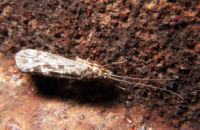
Photo from wikipedia
Worldwide seagrass populations are in decline, calling for urgent measures in their conservation. Glyphosate is the most widely used herbicide globally, leading to increasing concern about its ecological impact, yet… Click to show full abstract
Worldwide seagrass populations are in decline, calling for urgent measures in their conservation. Glyphosate is the most widely used herbicide globally, leading to increasing concern about its ecological impact, yet little is known about the prevalence or impact of glyphosate on seagrasses. In this study, we investigated the effect of sublethal glyphosate exposure on the endangered seagrass, Zostera capensis, to identify effects on growth, photosynthetic pigments and leaf morphology as measures of seagrass fitness. Seagrasses were exposed to a single dose of a commercial glyphosate formulation—ranging between 250 to 2,200 µg/L. After three weeks, the median leaf area decreased by up to 27%, with reductions of up to 31% in above ground biomass (p < 0.05). Photosynthetic pigment concentration showed no significant difference between groups. The observed effects on biomass and leaf area were seen at glyphosate levels below the regulatory limits set for surface water by several countries and may negatively affect the long-term resilience of this ecosystem engineer to additional stressors, such as those associated with climate change and anthropogenic pollution. As such, glyphosates and other herbicides that are washed into estuarine and marine ecosystems, pose a significant threat to the persistence of seagrasses and are important factors to consider in seagrass conservation, management and restoration efforts.
Journal Title: PeerJ
Year Published: 2022
Link to full text (if available)
Share on Social Media: Sign Up to like & get
recommendations!